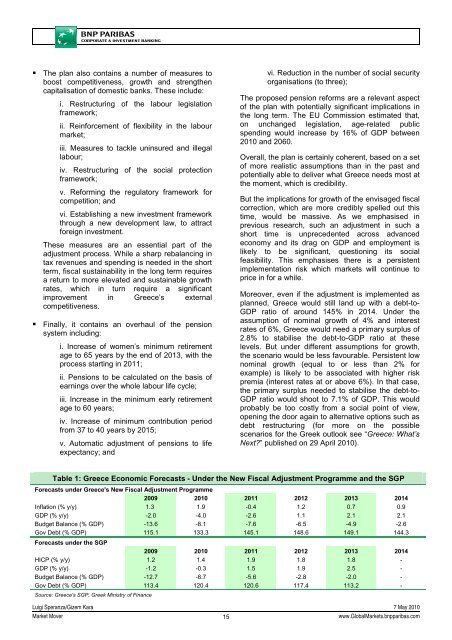Market Economics | Interest Rate Strategy - BNP PARIBAS ...
Market Economics | Interest Rate Strategy - BNP PARIBAS ...
Market Economics | Interest Rate Strategy - BNP PARIBAS ...
Create successful ePaper yourself
Turn your PDF publications into a flip-book with our unique Google optimized e-Paper software.
• The plan also contains a number of measures to<br />
boost competitiveness, growth and strengthen<br />
capitalisation of domestic banks. These include:<br />
i. Restructuring of the labour legislation<br />
framework;<br />
ii. Reinforcement of flexibility in the labour<br />
market;<br />
iii. Measures to tackle uninsured and illegal<br />
labour;<br />
iv. Restructuring of the social protection<br />
framework;<br />
v. Reforming the regulatory framework for<br />
competition; and<br />
vi. Establishing a new investment framework<br />
through a new development law, to attract<br />
foreign investment.<br />
These measures are an essential part of the<br />
adjustment process. While a sharp rebalancing in<br />
tax revenues and spending is needed in the short<br />
term, fiscal sustainability in the long term requires<br />
a return to more elevated and sustainable growth<br />
rates, which in turn require a significant<br />
improvement in Greece’s external<br />
competitiveness.<br />
• Finally, it contains an overhaul of the pension<br />
system including:<br />
i. Increase of women’s minimum retirement<br />
age to 65 years by the end of 2013, with the<br />
process starting in 2011;<br />
ii. Pensions to be calculated on the basis of<br />
earnings over the whole labour life cycle;<br />
iii. Increase in the minimum early retirement<br />
age to 60 years;<br />
iv. Increase of minimum contribution period<br />
from 37 to 40 years by 2015;<br />
v. Automatic adjustment of pensions to life<br />
expectancy; and<br />
vi. Reduction in the number of social security<br />
organisations (to three);<br />
The proposed pension reforms are a relevant aspect<br />
of the plan with potentially significant implications in<br />
the long term. The EU Commission estimated that,<br />
on unchanged legislation, age-related public<br />
spending would increase by 16% of GDP between<br />
2010 and 2060.<br />
Overall, the plan is certainly coherent, based on a set<br />
of more realistic assumptions than in the past and<br />
potentially able to deliver what Greece needs most at<br />
the moment, which is credibility.<br />
But the implications for growth of the envisaged fiscal<br />
correction, which are more credibly spelled out this<br />
time, would be massive. As we emphasised in<br />
previous research, such an adjustment in such a<br />
short time is unprecedented across advanced<br />
economy and its drag on GDP and employment is<br />
likely to be significant, questioning its social<br />
feasibility. This emphasises there is a persistent<br />
implementation risk which markets will continue to<br />
price in for a while.<br />
Moreover, even if the adjustment is implemented as<br />
planned, Greece would still land up with a debt-to-<br />
GDP ratio of around 145% in 2014. Under the<br />
assumption of nominal growth of 4% and interest<br />
rates of 6%, Greece would need a primary surplus of<br />
2.8% to stabilise the debt-to-GDP ratio at these<br />
levels. But under different assumptions for growth,<br />
the scenario would be less favourable. Persistent low<br />
nominal growth (equal to or less than 2% for<br />
example) is likely to be associated with higher risk<br />
premia (interest rates at or above 6%). In that case,<br />
the primary surplus needed to stabilise the debt-to-<br />
GDP ratio would shoot to 7.1% of GDP. This would<br />
probably be too costly from a social point of view,<br />
opening the door again to alternative options such as<br />
debt restructuring (for more on the possible<br />
scenarios for the Greek outlook see “Greece: What’s<br />
Next?” published on 29 April 2010).<br />
Table 1: Greece Economic Forecasts - Under the New Fiscal Adjustment Programme and the SGP<br />
Forecasts under Greece's New Fiscal Adjustment Programme<br />
2009 2010 2011 2012 2013 2014<br />
Inflation (% y/y) 1.3 1.9 -0.4 1.2 0.7 0.9<br />
GDP (% y/y) -2.0 -4.0 -2.6 1.1 2.1 2.1<br />
Budget Balance (% GDP) -13.6 -8.1 -7.6 -6.5 -4.9 -2.6<br />
Gov Debt (% GDP) 115.1 133.3 145.1 148.6 149.1 144.3<br />
Forecasts under the SGP<br />
2009 2010 2011 2012 2013 2014<br />
HICP (% y/y) 1.2 1.4 1.9 1.8 1.8 -<br />
GDP (% y/y) -1.2 -0.3 1.5 1.9 2.5 -<br />
Budget Balance (% GDP) -12.7 -8.7 -5.6 -2.8 -2.0 -<br />
Gov Debt (% GDP) 113.4 120.4 120.6 117.4 113.2 -<br />
Source: Greece's SGP, Greek Ministry of Finance<br />
Luigi Speranza/Gizem Kara 7 May 2010<br />
<strong>Market</strong> Mover<br />
15<br />
www.Global<strong>Market</strong>s.bnpparibas.com
















